Policy Brief: Indigenous People's Land Rights and Policy Analysis
VerifiedAdded on 2023/06/10
|7
|2082
|427
Report
AI Summary
This policy brief examines the critical issue of indigenous people's rights, with a particular focus on land and resource rights, drawing examples from Nepal. The brief highlights the importance of land and natural resources for the economic security, socio-cultural environment, and self-esteem of indigenous communities. It delves into the historical context of international law and policy, referencing key instruments such as UNDRIP and ILO Convention 169. The paper discusses the challenges faced by indigenous people in the context of globalization, land disputes, and the impact of nationalization acts. It further explores the implications of citizenship issues and the role of government policies in protecting indigenous rights, including an analysis of the Nepalese constitution. The brief concludes with recommendations for safeguarding indigenous rights, emphasizing self-governance, legislation, and the protection of traditional knowledge and skills. The report stresses the need for a comprehensive approach to ensure the welfare and rights of indigenous populations.
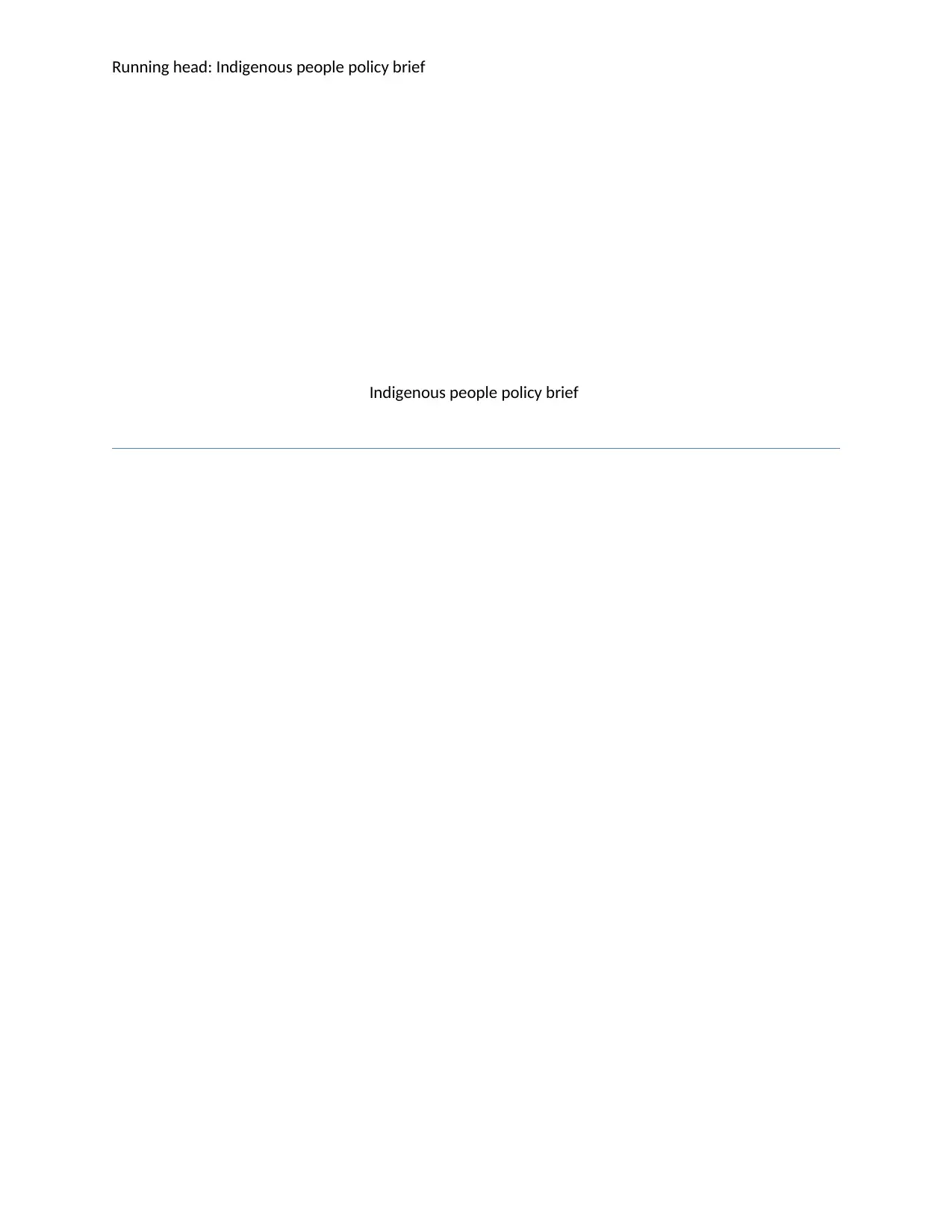
Running head: Indigenous people policy brief
Indigenous people policy brief
Indigenous people policy brief
Paraphrase This Document
Need a fresh take? Get an instant paraphrase of this document with our AI Paraphraser
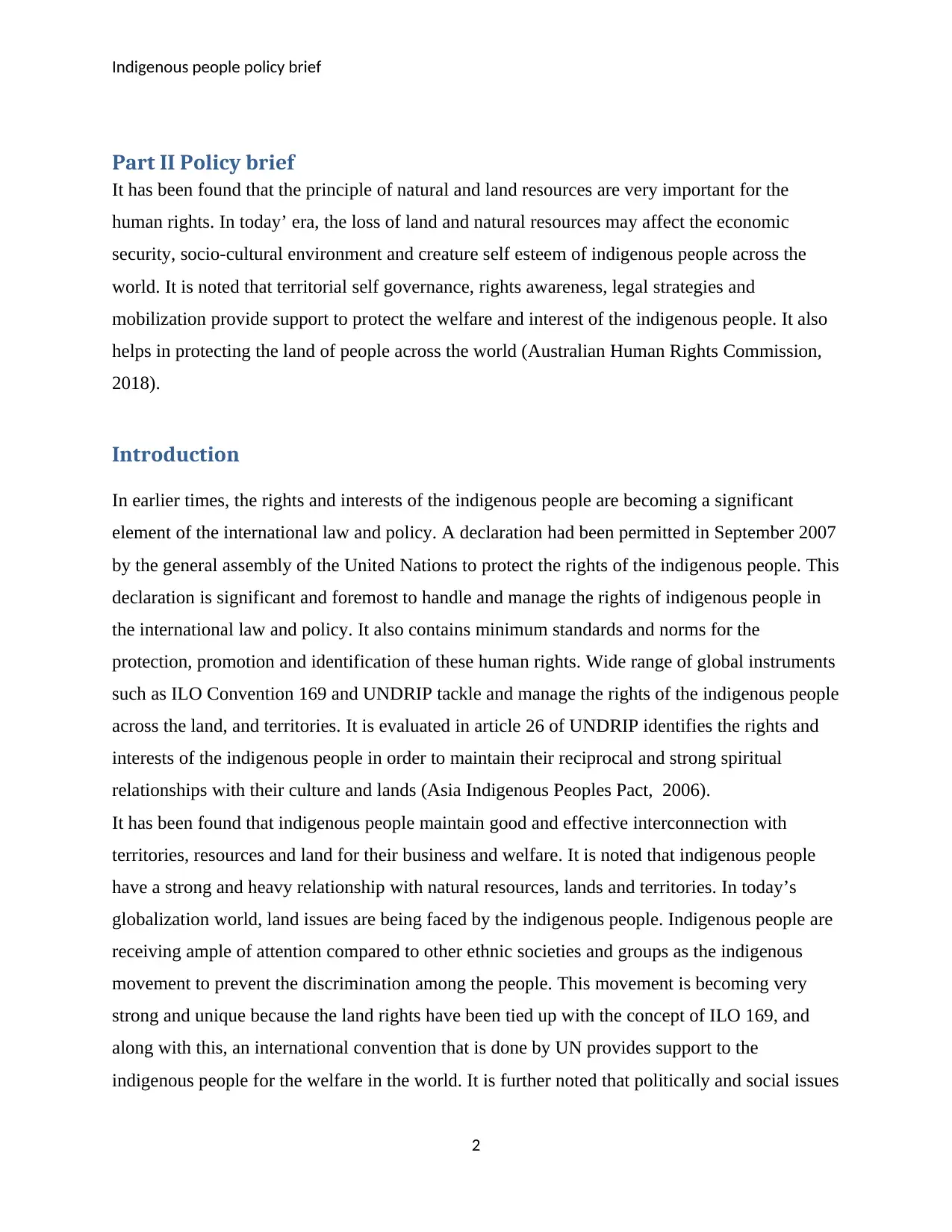
Indigenous people policy brief
Part II Policy brief
It has been found that the principle of natural and land resources are very important for the
human rights. In today’ era, the loss of land and natural resources may affect the economic
security, socio-cultural environment and creature self esteem of indigenous people across the
world. It is noted that territorial self governance, rights awareness, legal strategies and
mobilization provide support to protect the welfare and interest of the indigenous people. It also
helps in protecting the land of people across the world (Australian Human Rights Commission,
2018).
Introduction
In earlier times, the rights and interests of the indigenous people are becoming a significant
element of the international law and policy. A declaration had been permitted in September 2007
by the general assembly of the United Nations to protect the rights of the indigenous people. This
declaration is significant and foremost to handle and manage the rights of indigenous people in
the international law and policy. It also contains minimum standards and norms for the
protection, promotion and identification of these human rights. Wide range of global instruments
such as ILO Convention 169 and UNDRIP tackle and manage the rights of the indigenous people
across the land, and territories. It is evaluated in article 26 of UNDRIP identifies the rights and
interests of the indigenous people in order to maintain their reciprocal and strong spiritual
relationships with their culture and lands (Asia Indigenous Peoples Pact, 2006).
It has been found that indigenous people maintain good and effective interconnection with
territories, resources and land for their business and welfare. It is noted that indigenous people
have a strong and heavy relationship with natural resources, lands and territories. In today’s
globalization world, land issues are being faced by the indigenous people. Indigenous people are
receiving ample of attention compared to other ethnic societies and groups as the indigenous
movement to prevent the discrimination among the people. This movement is becoming very
strong and unique because the land rights have been tied up with the concept of ILO 169, and
along with this, an international convention that is done by UN provides support to the
indigenous people for the welfare in the world. It is further noted that politically and social issues
2
Part II Policy brief
It has been found that the principle of natural and land resources are very important for the
human rights. In today’ era, the loss of land and natural resources may affect the economic
security, socio-cultural environment and creature self esteem of indigenous people across the
world. It is noted that territorial self governance, rights awareness, legal strategies and
mobilization provide support to protect the welfare and interest of the indigenous people. It also
helps in protecting the land of people across the world (Australian Human Rights Commission,
2018).
Introduction
In earlier times, the rights and interests of the indigenous people are becoming a significant
element of the international law and policy. A declaration had been permitted in September 2007
by the general assembly of the United Nations to protect the rights of the indigenous people. This
declaration is significant and foremost to handle and manage the rights of indigenous people in
the international law and policy. It also contains minimum standards and norms for the
protection, promotion and identification of these human rights. Wide range of global instruments
such as ILO Convention 169 and UNDRIP tackle and manage the rights of the indigenous people
across the land, and territories. It is evaluated in article 26 of UNDRIP identifies the rights and
interests of the indigenous people in order to maintain their reciprocal and strong spiritual
relationships with their culture and lands (Asia Indigenous Peoples Pact, 2006).
It has been found that indigenous people maintain good and effective interconnection with
territories, resources and land for their business and welfare. It is noted that indigenous people
have a strong and heavy relationship with natural resources, lands and territories. In today’s
globalization world, land issues are being faced by the indigenous people. Indigenous people are
receiving ample of attention compared to other ethnic societies and groups as the indigenous
movement to prevent the discrimination among the people. This movement is becoming very
strong and unique because the land rights have been tied up with the concept of ILO 169, and
along with this, an international convention that is done by UN provides support to the
indigenous people for the welfare in the world. It is further noted that politically and social issues
2
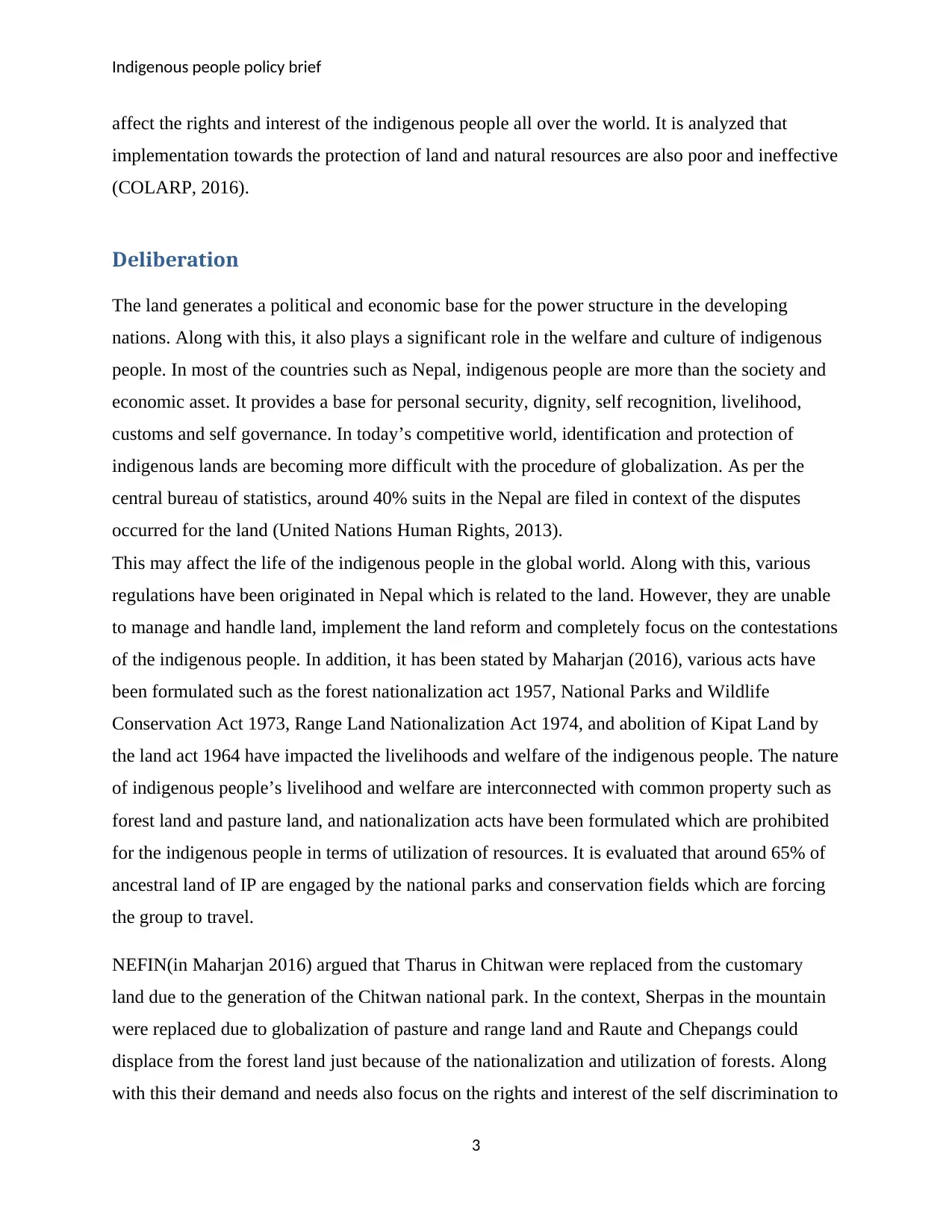
Indigenous people policy brief
affect the rights and interest of the indigenous people all over the world. It is analyzed that
implementation towards the protection of land and natural resources are also poor and ineffective
(COLARP, 2016).
Deliberation
The land generates a political and economic base for the power structure in the developing
nations. Along with this, it also plays a significant role in the welfare and culture of indigenous
people. In most of the countries such as Nepal, indigenous people are more than the society and
economic asset. It provides a base for personal security, dignity, self recognition, livelihood,
customs and self governance. In today’s competitive world, identification and protection of
indigenous lands are becoming more difficult with the procedure of globalization. As per the
central bureau of statistics, around 40% suits in the Nepal are filed in context of the disputes
occurred for the land (United Nations Human Rights, 2013).
This may affect the life of the indigenous people in the global world. Along with this, various
regulations have been originated in Nepal which is related to the land. However, they are unable
to manage and handle land, implement the land reform and completely focus on the contestations
of the indigenous people. In addition, it has been stated by Maharjan (2016), various acts have
been formulated such as the forest nationalization act 1957, National Parks and Wildlife
Conservation Act 1973, Range Land Nationalization Act 1974, and abolition of Kipat Land by
the land act 1964 have impacted the livelihoods and welfare of the indigenous people. The nature
of indigenous people’s livelihood and welfare are interconnected with common property such as
forest land and pasture land, and nationalization acts have been formulated which are prohibited
for the indigenous people in terms of utilization of resources. It is evaluated that around 65% of
ancestral land of IP are engaged by the national parks and conservation fields which are forcing
the group to travel.
NEFIN(in Maharjan 2016) argued that Tharus in Chitwan were replaced from the customary
land due to the generation of the Chitwan national park. In the context, Sherpas in the mountain
were replaced due to globalization of pasture and range land and Raute and Chepangs could
displace from the forest land just because of the nationalization and utilization of forests. Along
with this their demand and needs also focus on the rights and interest of the self discrimination to
3
affect the rights and interest of the indigenous people all over the world. It is analyzed that
implementation towards the protection of land and natural resources are also poor and ineffective
(COLARP, 2016).
Deliberation
The land generates a political and economic base for the power structure in the developing
nations. Along with this, it also plays a significant role in the welfare and culture of indigenous
people. In most of the countries such as Nepal, indigenous people are more than the society and
economic asset. It provides a base for personal security, dignity, self recognition, livelihood,
customs and self governance. In today’s competitive world, identification and protection of
indigenous lands are becoming more difficult with the procedure of globalization. As per the
central bureau of statistics, around 40% suits in the Nepal are filed in context of the disputes
occurred for the land (United Nations Human Rights, 2013).
This may affect the life of the indigenous people in the global world. Along with this, various
regulations have been originated in Nepal which is related to the land. However, they are unable
to manage and handle land, implement the land reform and completely focus on the contestations
of the indigenous people. In addition, it has been stated by Maharjan (2016), various acts have
been formulated such as the forest nationalization act 1957, National Parks and Wildlife
Conservation Act 1973, Range Land Nationalization Act 1974, and abolition of Kipat Land by
the land act 1964 have impacted the livelihoods and welfare of the indigenous people. The nature
of indigenous people’s livelihood and welfare are interconnected with common property such as
forest land and pasture land, and nationalization acts have been formulated which are prohibited
for the indigenous people in terms of utilization of resources. It is evaluated that around 65% of
ancestral land of IP are engaged by the national parks and conservation fields which are forcing
the group to travel.
NEFIN(in Maharjan 2016) argued that Tharus in Chitwan were replaced from the customary
land due to the generation of the Chitwan national park. In the context, Sherpas in the mountain
were replaced due to globalization of pasture and range land and Raute and Chepangs could
displace from the forest land just because of the nationalization and utilization of forests. Along
with this their demand and needs also focus on the rights and interest of the self discrimination to
3
⊘ This is a preview!⊘
Do you want full access?
Subscribe today to unlock all pages.

Trusted by 1+ million students worldwide
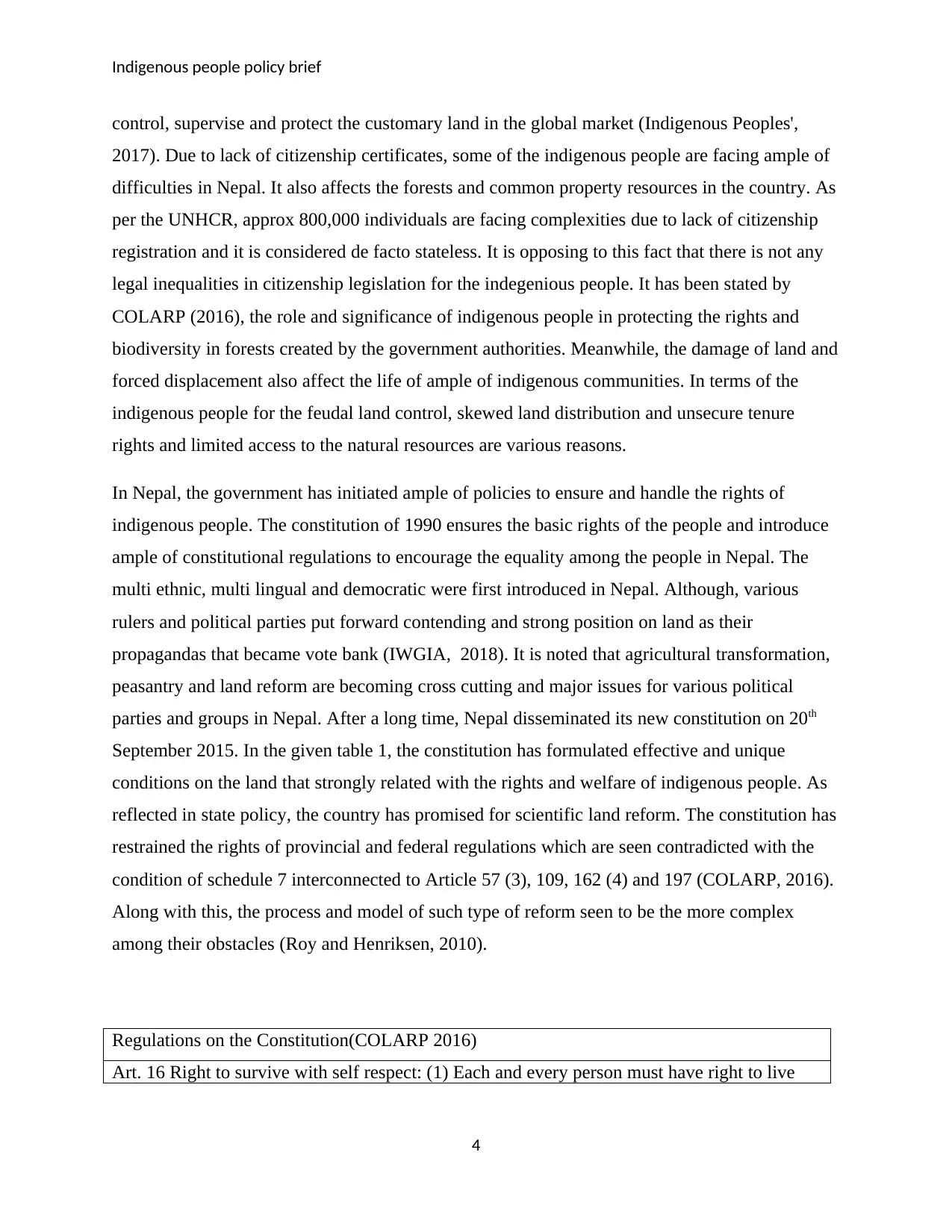
Indigenous people policy brief
control, supervise and protect the customary land in the global market (Indigenous Peoples',
2017). Due to lack of citizenship certificates, some of the indigenous people are facing ample of
difficulties in Nepal. It also affects the forests and common property resources in the country. As
per the UNHCR, approx 800,000 individuals are facing complexities due to lack of citizenship
registration and it is considered de facto stateless. It is opposing to this fact that there is not any
legal inequalities in citizenship legislation for the indegenious people. It has been stated by
COLARP (2016), the role and significance of indigenous people in protecting the rights and
biodiversity in forests created by the government authorities. Meanwhile, the damage of land and
forced displacement also affect the life of ample of indigenous communities. In terms of the
indigenous people for the feudal land control, skewed land distribution and unsecure tenure
rights and limited access to the natural resources are various reasons.
In Nepal, the government has initiated ample of policies to ensure and handle the rights of
indigenous people. The constitution of 1990 ensures the basic rights of the people and introduce
ample of constitutional regulations to encourage the equality among the people in Nepal. The
multi ethnic, multi lingual and democratic were first introduced in Nepal. Although, various
rulers and political parties put forward contending and strong position on land as their
propagandas that became vote bank (IWGIA, 2018). It is noted that agricultural transformation,
peasantry and land reform are becoming cross cutting and major issues for various political
parties and groups in Nepal. After a long time, Nepal disseminated its new constitution on 20th
September 2015. In the given table 1, the constitution has formulated effective and unique
conditions on the land that strongly related with the rights and welfare of indigenous people. As
reflected in state policy, the country has promised for scientific land reform. The constitution has
restrained the rights of provincial and federal regulations which are seen contradicted with the
condition of schedule 7 interconnected to Article 57 (3), 109, 162 (4) and 197 (COLARP, 2016).
Along with this, the process and model of such type of reform seen to be the more complex
among their obstacles (Roy and Henriksen, 2010).
Regulations on the Constitution(COLARP 2016)
Art. 16 Right to survive with self respect: (1) Each and every person must have right to live
4
control, supervise and protect the customary land in the global market (Indigenous Peoples',
2017). Due to lack of citizenship certificates, some of the indigenous people are facing ample of
difficulties in Nepal. It also affects the forests and common property resources in the country. As
per the UNHCR, approx 800,000 individuals are facing complexities due to lack of citizenship
registration and it is considered de facto stateless. It is opposing to this fact that there is not any
legal inequalities in citizenship legislation for the indegenious people. It has been stated by
COLARP (2016), the role and significance of indigenous people in protecting the rights and
biodiversity in forests created by the government authorities. Meanwhile, the damage of land and
forced displacement also affect the life of ample of indigenous communities. In terms of the
indigenous people for the feudal land control, skewed land distribution and unsecure tenure
rights and limited access to the natural resources are various reasons.
In Nepal, the government has initiated ample of policies to ensure and handle the rights of
indigenous people. The constitution of 1990 ensures the basic rights of the people and introduce
ample of constitutional regulations to encourage the equality among the people in Nepal. The
multi ethnic, multi lingual and democratic were first introduced in Nepal. Although, various
rulers and political parties put forward contending and strong position on land as their
propagandas that became vote bank (IWGIA, 2018). It is noted that agricultural transformation,
peasantry and land reform are becoming cross cutting and major issues for various political
parties and groups in Nepal. After a long time, Nepal disseminated its new constitution on 20th
September 2015. In the given table 1, the constitution has formulated effective and unique
conditions on the land that strongly related with the rights and welfare of indigenous people. As
reflected in state policy, the country has promised for scientific land reform. The constitution has
restrained the rights of provincial and federal regulations which are seen contradicted with the
condition of schedule 7 interconnected to Article 57 (3), 109, 162 (4) and 197 (COLARP, 2016).
Along with this, the process and model of such type of reform seen to be the more complex
among their obstacles (Roy and Henriksen, 2010).
Regulations on the Constitution(COLARP 2016)
Art. 16 Right to survive with self respect: (1) Each and every person must have right to live
4
Paraphrase This Document
Need a fresh take? Get an instant paraphrase of this document with our AI Paraphraser
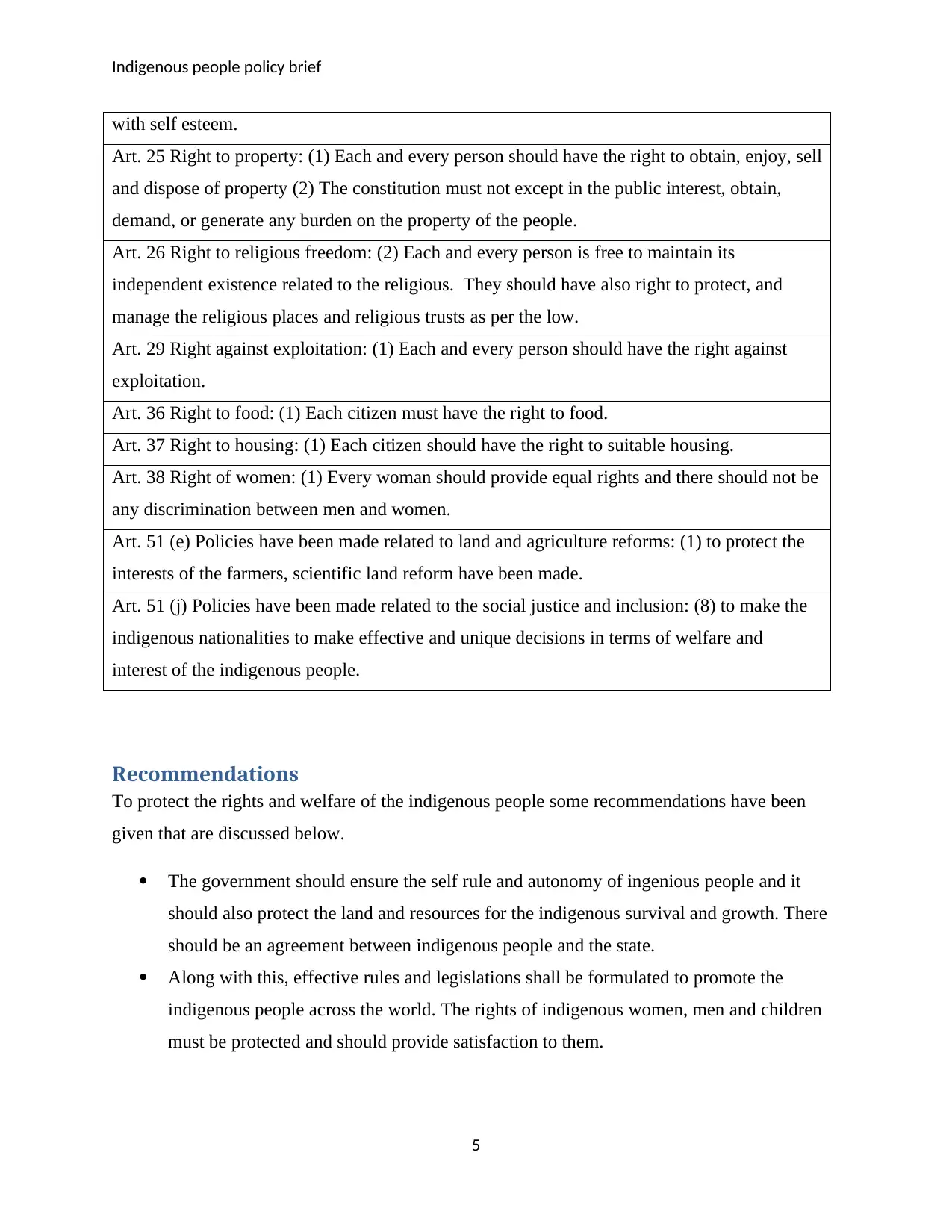
Indigenous people policy brief
with self esteem.
Art. 25 Right to property: (1) Each and every person should have the right to obtain, enjoy, sell
and dispose of property (2) The constitution must not except in the public interest, obtain,
demand, or generate any burden on the property of the people.
Art. 26 Right to religious freedom: (2) Each and every person is free to maintain its
independent existence related to the religious. They should have also right to protect, and
manage the religious places and religious trusts as per the low.
Art. 29 Right against exploitation: (1) Each and every person should have the right against
exploitation.
Art. 36 Right to food: (1) Each citizen must have the right to food.
Art. 37 Right to housing: (1) Each citizen should have the right to suitable housing.
Art. 38 Right of women: (1) Every woman should provide equal rights and there should not be
any discrimination between men and women.
Art. 51 (e) Policies have been made related to land and agriculture reforms: (1) to protect the
interests of the farmers, scientific land reform have been made.
Art. 51 (j) Policies have been made related to the social justice and inclusion: (8) to make the
indigenous nationalities to make effective and unique decisions in terms of welfare and
interest of the indigenous people.
Recommendations
To protect the rights and welfare of the indigenous people some recommendations have been
given that are discussed below.
The government should ensure the self rule and autonomy of ingenious people and it
should also protect the land and resources for the indigenous survival and growth. There
should be an agreement between indigenous people and the state.
Along with this, effective rules and legislations shall be formulated to promote the
indigenous people across the world. The rights of indigenous women, men and children
must be protected and should provide satisfaction to them.
5
with self esteem.
Art. 25 Right to property: (1) Each and every person should have the right to obtain, enjoy, sell
and dispose of property (2) The constitution must not except in the public interest, obtain,
demand, or generate any burden on the property of the people.
Art. 26 Right to religious freedom: (2) Each and every person is free to maintain its
independent existence related to the religious. They should have also right to protect, and
manage the religious places and religious trusts as per the low.
Art. 29 Right against exploitation: (1) Each and every person should have the right against
exploitation.
Art. 36 Right to food: (1) Each citizen must have the right to food.
Art. 37 Right to housing: (1) Each citizen should have the right to suitable housing.
Art. 38 Right of women: (1) Every woman should provide equal rights and there should not be
any discrimination between men and women.
Art. 51 (e) Policies have been made related to land and agriculture reforms: (1) to protect the
interests of the farmers, scientific land reform have been made.
Art. 51 (j) Policies have been made related to the social justice and inclusion: (8) to make the
indigenous nationalities to make effective and unique decisions in terms of welfare and
interest of the indigenous people.
Recommendations
To protect the rights and welfare of the indigenous people some recommendations have been
given that are discussed below.
The government should ensure the self rule and autonomy of ingenious people and it
should also protect the land and resources for the indigenous survival and growth. There
should be an agreement between indigenous people and the state.
Along with this, effective rules and legislations shall be formulated to promote the
indigenous people across the world. The rights of indigenous women, men and children
must be protected and should provide satisfaction to them.
5
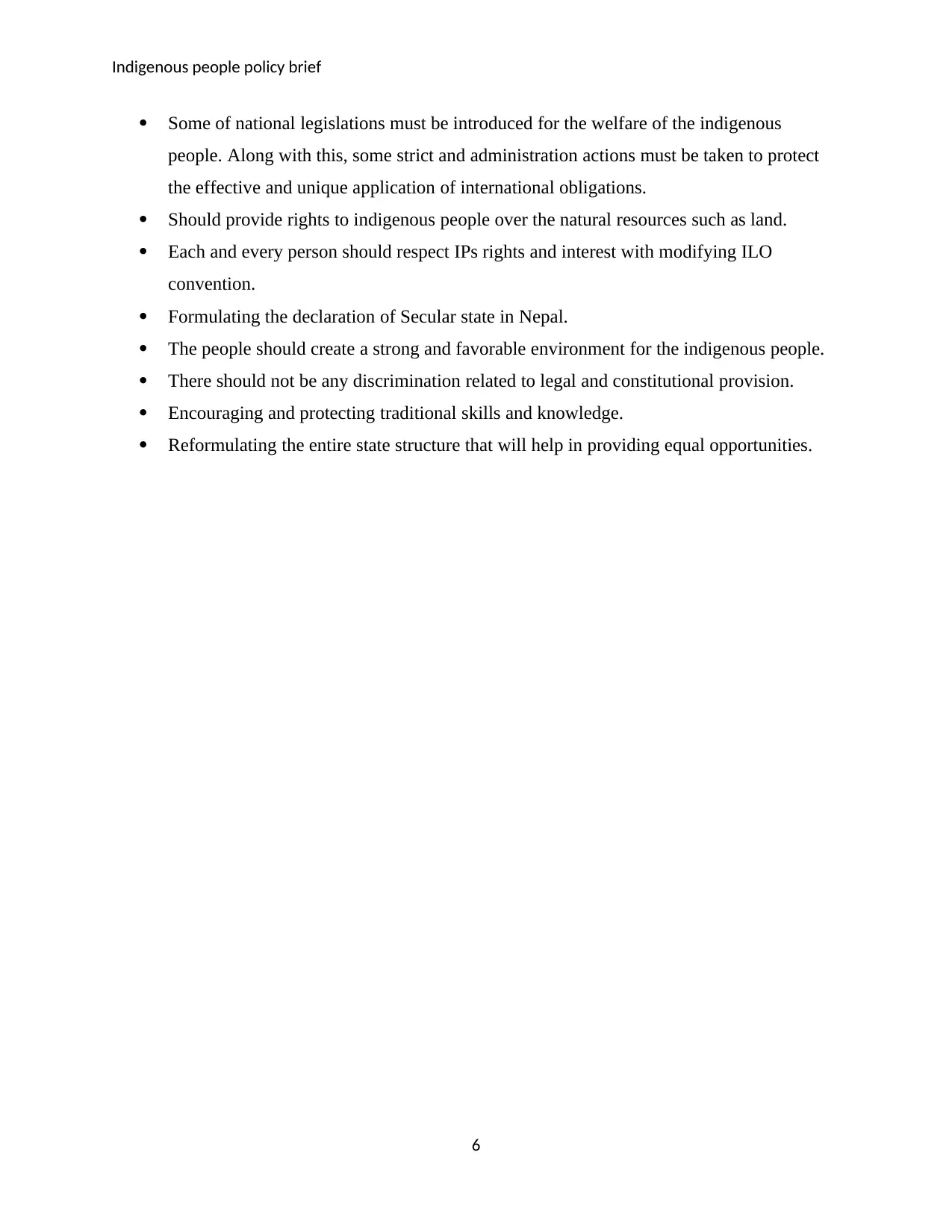
Indigenous people policy brief
Some of national legislations must be introduced for the welfare of the indigenous
people. Along with this, some strict and administration actions must be taken to protect
the effective and unique application of international obligations.
Should provide rights to indigenous people over the natural resources such as land.
Each and every person should respect IPs rights and interest with modifying ILO
convention.
Formulating the declaration of Secular state in Nepal.
The people should create a strong and favorable environment for the indigenous people.
There should not be any discrimination related to legal and constitutional provision.
Encouraging and protecting traditional skills and knowledge.
Reformulating the entire state structure that will help in providing equal opportunities.
6
Some of national legislations must be introduced for the welfare of the indigenous
people. Along with this, some strict and administration actions must be taken to protect
the effective and unique application of international obligations.
Should provide rights to indigenous people over the natural resources such as land.
Each and every person should respect IPs rights and interest with modifying ILO
convention.
Formulating the declaration of Secular state in Nepal.
The people should create a strong and favorable environment for the indigenous people.
There should not be any discrimination related to legal and constitutional provision.
Encouraging and protecting traditional skills and knowledge.
Reformulating the entire state structure that will help in providing equal opportunities.
6
⊘ This is a preview!⊘
Do you want full access?
Subscribe today to unlock all pages.

Trusted by 1+ million students worldwide
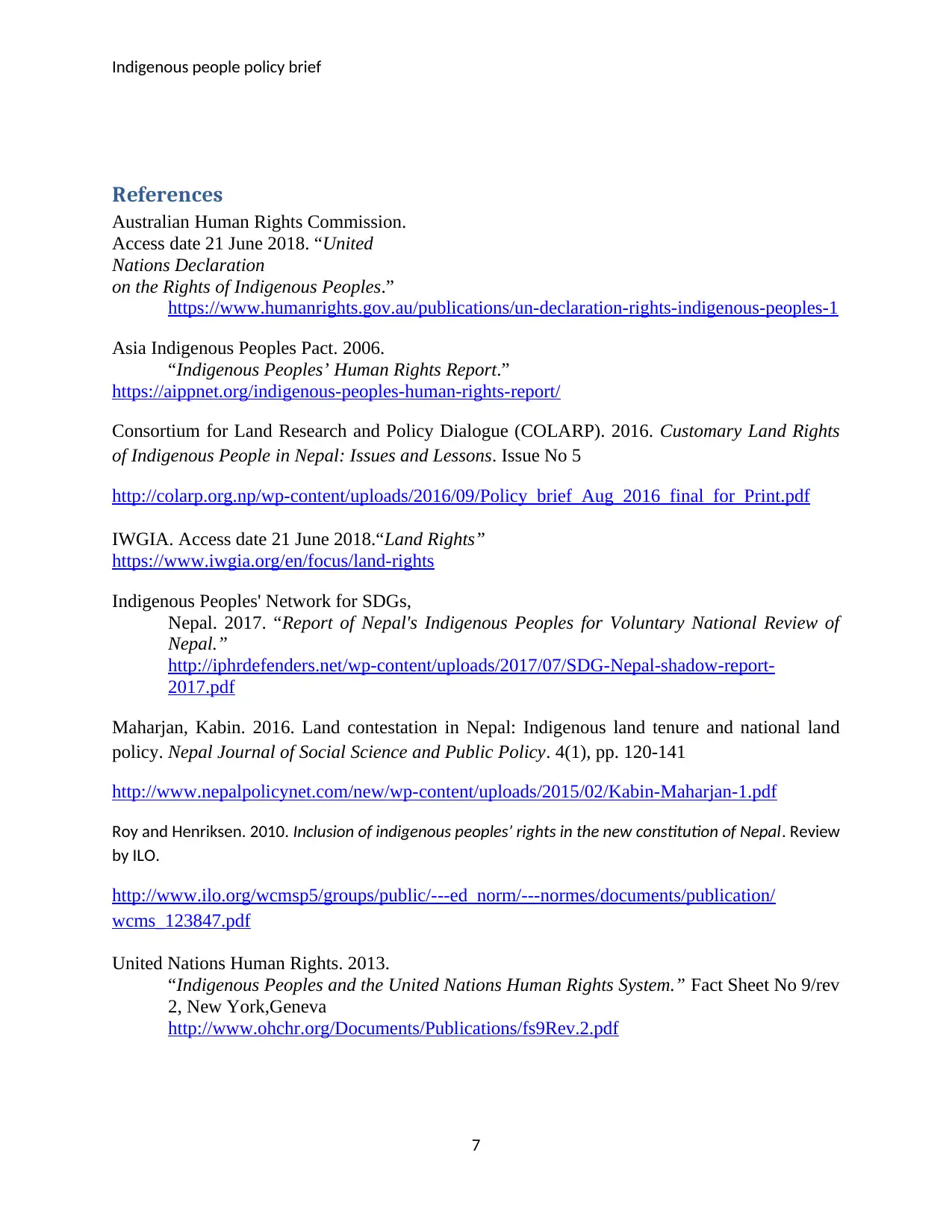
Indigenous people policy brief
References
Australian Human Rights Commission.
Access date 21 June 2018. “United
Nations Declaration
on the Rights of Indigenous Peoples.”
https://www.humanrights.gov.au/publications/un-declaration-rights-indigenous-peoples-1
Asia Indigenous Peoples Pact. 2006.
“Indigenous Peoples’ Human Rights Report.”
https://aippnet.org/indigenous-peoples-human-rights-report/
Consortium for Land Research and Policy Dialogue (COLARP). 2016. Customary Land Rights
of Indigenous People in Nepal: Issues and Lessons. Issue No 5
http://colarp.org.np/wp-content/uploads/2016/09/Policy_brief_Aug_2016_final_for_Print.pdf
IWGIA. Access date 21 June 2018.“Land Rights”
https://www.iwgia.org/en/focus/land-rights
Indigenous Peoples' Network for SDGs,
Nepal. 2017. “Report of Nepal's Indigenous Peoples for Voluntary National Review of
Nepal.”
http://iphrdefenders.net/wp-content/uploads/2017/07/SDG-Nepal-shadow-report-
2017.pdf
Maharjan, Kabin. 2016. Land contestation in Nepal: Indigenous land tenure and national land
policy. Nepal Journal of Social Science and Public Policy. 4(1), pp. 120-141
http://www.nepalpolicynet.com/new/wp-content/uploads/2015/02/Kabin-Maharjan-1.pdf
Roy and Henriksen. 2010. Inclusion of indigenous peoples’ rights in the new constitution of Nepal. Review
by ILO.
http://www.ilo.org/wcmsp5/groups/public/---ed_norm/---normes/documents/publication/
wcms_123847.pdf
United Nations Human Rights. 2013.
“Indigenous Peoples and the United Nations Human Rights System.” Fact Sheet No 9/rev
2, New York,Geneva
http://www.ohchr.org/Documents/Publications/fs9Rev.2.pdf
7
References
Australian Human Rights Commission.
Access date 21 June 2018. “United
Nations Declaration
on the Rights of Indigenous Peoples.”
https://www.humanrights.gov.au/publications/un-declaration-rights-indigenous-peoples-1
Asia Indigenous Peoples Pact. 2006.
“Indigenous Peoples’ Human Rights Report.”
https://aippnet.org/indigenous-peoples-human-rights-report/
Consortium for Land Research and Policy Dialogue (COLARP). 2016. Customary Land Rights
of Indigenous People in Nepal: Issues and Lessons. Issue No 5
http://colarp.org.np/wp-content/uploads/2016/09/Policy_brief_Aug_2016_final_for_Print.pdf
IWGIA. Access date 21 June 2018.“Land Rights”
https://www.iwgia.org/en/focus/land-rights
Indigenous Peoples' Network for SDGs,
Nepal. 2017. “Report of Nepal's Indigenous Peoples for Voluntary National Review of
Nepal.”
http://iphrdefenders.net/wp-content/uploads/2017/07/SDG-Nepal-shadow-report-
2017.pdf
Maharjan, Kabin. 2016. Land contestation in Nepal: Indigenous land tenure and national land
policy. Nepal Journal of Social Science and Public Policy. 4(1), pp. 120-141
http://www.nepalpolicynet.com/new/wp-content/uploads/2015/02/Kabin-Maharjan-1.pdf
Roy and Henriksen. 2010. Inclusion of indigenous peoples’ rights in the new constitution of Nepal. Review
by ILO.
http://www.ilo.org/wcmsp5/groups/public/---ed_norm/---normes/documents/publication/
wcms_123847.pdf
United Nations Human Rights. 2013.
“Indigenous Peoples and the United Nations Human Rights System.” Fact Sheet No 9/rev
2, New York,Geneva
http://www.ohchr.org/Documents/Publications/fs9Rev.2.pdf
7
1 out of 7
Your All-in-One AI-Powered Toolkit for Academic Success.
+13062052269
info@desklib.com
Available 24*7 on WhatsApp / Email
![[object Object]](/_next/static/media/star-bottom.7253800d.svg)
Unlock your academic potential
Copyright © 2020–2025 A2Z Services. All Rights Reserved. Developed and managed by ZUCOL.

